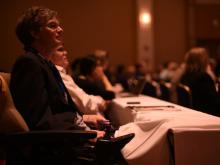Thursday’s afternoon sessions focused on therapeutic approaches now in development
Here are some highlights:
- Duchenne muscular dystrophy (DMD): Dean Burkin from the University of Nevada, Reno, presented his team’s findings that show how raising levels of a protein called alpha 7 beta 1 integrin has potential as a therapy for treating Duchenne muscular dystrophy. A key factor in DMD is that absence of the dystrophin protein in muscle fibers causes the membrane surrounding each fiber to be overly fragile and vulnerable to damage from muscle contractions. Burkin’s team found that, in mouse models of DMD, enhancing alpha 7 beta 1 integrin can improve the usual disease course, apparently by making membranes less fragile. The investigators have identified six small molecules and two proteins (large molecules) that increase levels of the desired integrin protein in skeletal muscles. These are all possible staring points for therapy development for DMD and potentially for other muscular dystrophies.
- Pompe disease: Gary Todd from the University of Florida reported on his group’s experiments to develop gene transfer therapy for Pompe disease, a metabolic muscle disorder that results from a deficiency of the acid maltase enzyme, also known as GAA, and involves weakness of the skeletal and cardiac muscles. Mutations in the gene for GAA are the cause of the enzyme deficiency. Todd and his colleagues conducted experiments in GAA-deficient mice with a Pompe-like disease, giving them functional GAA genes encased in viral shells. They found that early treatment was more effective than later treatment.
- DMD: Charles Gersbach from Duke University presented his group’s findings on a strategy known as “genome editing” as a potential treatment for DMD. These investigators conducted experiments in muscle cells taken from DMD patients and grown in a lab dish. The genome editing method they used is known as “CRISPR-Cas9,” and it can remove specific sections of a flawed dystrophin gene in such a way that shortened, but functional, dystrophin protein is made. The strategy acts at the DNA level, which could provide a permanent correction.
- DMD: Dongsheng Duan fom the University of Missouri presented his lab’s findings from experiments with dystrophin gene transfer therapy administered to dogs with a DMD-like disease. The dogs, which are closer to humans in size and in certain other aspects than are mice, showed benefit to their muscles from injection of miniaturized dystrophin genes encased in viral shells. The findings may help pave the way for new clinical trials of dystrophin gene therapy.
 DMD: Jeffrey Chamberlain from the University of Washington, Seattle, is developing gene transfer therapy for DMD by experimenting with highly miniaturized dystrophin genes encased in various types of viral shells. Chamberlain’s group has had particular success with a viral delivery system known as AAV6 in dystrophin-deficient mice and dogs as well as in human cells in a culture dish. Along with the work of Dongsheng Duan and others, these experiments have the potential to lead to new clinical trials of dystrophin gene transfer and ultimately to improvements in this strategy.
DMD: Jeffrey Chamberlain from the University of Washington, Seattle, is developing gene transfer therapy for DMD by experimenting with highly miniaturized dystrophin genes encased in various types of viral shells. Chamberlain’s group has had particular success with a viral delivery system known as AAV6 in dystrophin-deficient mice and dogs as well as in human cells in a culture dish. Along with the work of Dongsheng Duan and others, these experiments have the potential to lead to new clinical trials of dystrophin gene transfer and ultimately to improvements in this strategy.- Limb-girdle muscular dystrophy (LGMD): Jyoti Jaiswal from George Washington University presented his group’s efforts to develop a treatment for type 2B limb-girdle muscular dystrophy (LGMD2B), which is caused by mutations in the gene for the dysferlin protein and a deficiency of this protein in muscle fibers. Dysferlin appears to be necessary for the maintenance and repair of the membranes surrounding muscle fibers. Without it, injury-triggered secretion of a “healing” enzyme known as ASM is delayed and reduced, leading to a poor repair result. Treating dysferlin-deficient mouse and human cells with ASM improved membrane repair, as did treating them with an experimental anti-inflammatory compound called VBP15, which is now in development as a possible DMD treatment. Either or both compounds appear to have potential for treating LGMD2B.
Roxan Olivas
MDA Vice President — Public Relations & Community Programs
(520) 529-5317
rolivas@mdausa.org
